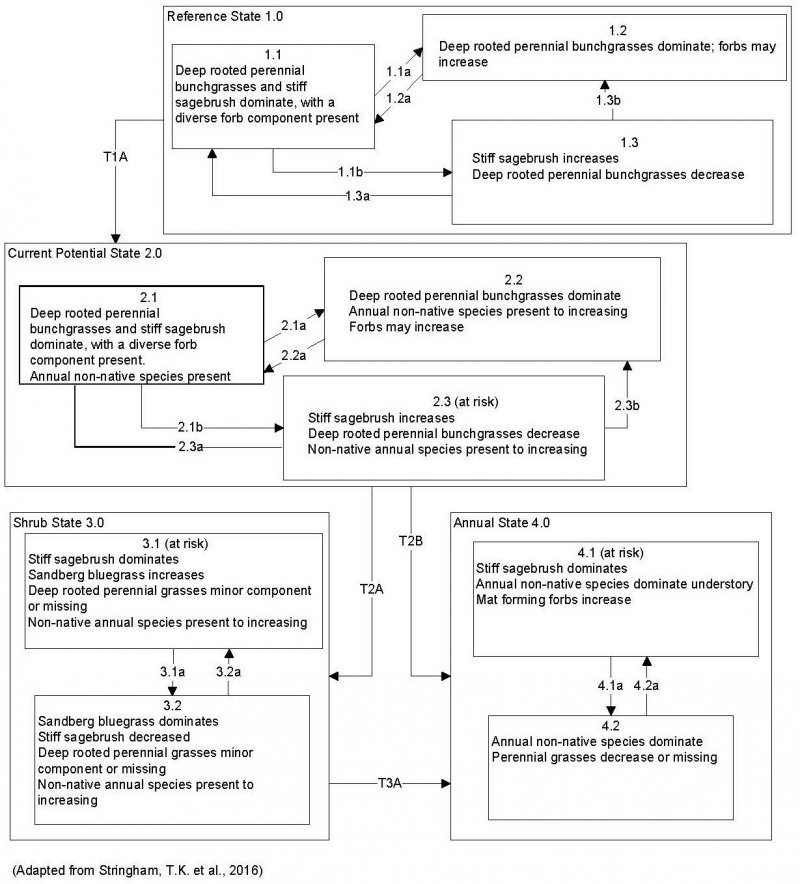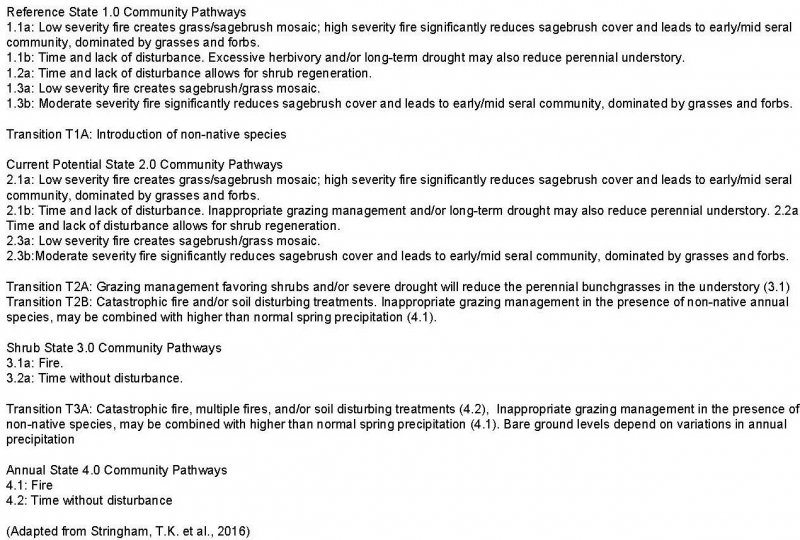
Natural Resources
Conservation Service
Ecological site R043CY806OR
Very Shallow Scabland (ARRI2/PSSPS-POSE)
Last updated: 9/08/2023
Accessed: 12/24/2024
General information
Provisional. A provisional ecological site description has undergone quality control and quality assurance review. It contains a working state and transition model and enough information to identify the ecological site.
MLRA notes
Major Land Resource Area (MLRA): 043C–Blue and Seven Devils Mountains
This MLRA covers the Blue and Seven Devils Mountains of Oregon, Washington and Idaho. The area is characterized by thrust and block-faulted mountains and deep canyons composed of sedimentary, metasedimentary, and volcanic rocks. Elevations range from 1,300 to 9,800 feet (395 to 2,990 meters). The climate is characterized by cold, wet winters and cool, dry summers. Annual precipitation, mostly in the form of snow, averages 12 to 43 inches (305 to 1,090 millimeters) yet ranges as high as 82 inches (2,085 millimeters) at upper elevations. Soil temperature regimes are predominately Frigid to Cryic and soil moisture regimes are predominately Xeric to Udic. Mollisols and Andisols are the dominant soil orders. Ecologically, forests dominate but shrub and grass communities may occur on south aspects and lower elevations as well as in alpine meadow environments. Forest composition follows moisture, temperature and elevational gradients and typically ranges from ponderosa pine and Douglas-fir plant associations at lower elevations, grand fir at middle elevations and subalpine fir and Engelman spruce at upper elevations. Historical fire regimes associated with these forest types range from frequent surface fires in ponderosa pine - Douglas Fir forest types to mixed and stand replacing fire regimes in grand fir and subalpine fir types. A large percentage of the MLRA is federally owned and managed by the U.S. Forest Service for multiple uses.
Classification relationships
Plant Assoc. of Blue and Ochoco Mountains (R6 E TP-036-92)
Stiff sagebrush/Sandberg bluegrass - SD9111
USDA Forest Service Ecological Sub-region
M332 “Blue Mountains”
U.S. National Vegetation Classification Standard (NVCS)
Group: G307. Columbia Plateau Scabland Dwarf-shrubland
Alliance: A1574. Artemisia rigida Steppe & Shrubland Alliance
Ecological site concept
This site occurs on upland plateaus with very shallow soils over hard igneous extrusive geologies (basalt, andesite, rhyolite, tuff, etc.). In the reference state, the site is characterized by stiff sagebrush (Artemisia rigida), bluebunch wheatgrass (Pseudoroegneria spicata) and Sandberg bluegrass (Poa secunda). This is a low production site. Production is limited by the low water holding capacity of the soil. Precipitation comes in the form of snow and rain primarily in the winter and early spring. The soil profile is not able to store all the moisture that the site receives, and excess moves to adjacent sites. In areas where the entire soil profile stays wet into the late spring, one-spike oatgrass (Danthonia unispicata) is common. Historically, plant community dynamics were driven primarily by disturbances such as localized fire and drought.
This is a provisional ecological site that groups characteristics at a broad scale with little to no field verification and is subject to extensive review and revision before final approval. All data herein was developed using existing information and literature and should be considered provisional and contingent upon field validation prior to use in conservation planning.
Associated sites
| F043CY608OR |
Cool Dry Conifer Foothills and Mountains (PIPO/FEID-PSSPS) Deeper soils, forested with ponderosa pine |
|---|
Similar sites
| R043CY807OR |
Scabland (PSSPS-POSE-DAUN) Influenced by maritime climate thus does not have as much of a shrub (ARRI2) component |
|---|
Table 1. Dominant plant species
| Tree |
Not specified |
|---|---|
| Shrub |
(1) Artemisia rigida |
| Herbaceous |
(1) Pseudoroegneria spicata |
Click on box and path labels to scroll to the respective text.
Ecosystem states
| T1A | - | Introduction of non-native species |
|---|---|---|
| T2A | - | Grazing management favoring shrubs and/or severe drought will reduce the perennial bunchgrasses in the understory |
| T2B | - | Catastrophic fire, and/or soil disturbing treatments/activities. Inappropriate grazing management in the presence of non-native annual species, may be combined with higher than normal spring precipitation |
| T3A | - | Catastrophic fire, and/or soil disturbing treatments/activities. Inappropriate grazing management in the presence of non-native annual species, may be combined with higher than normal spring precipitation |

